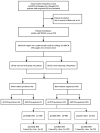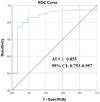Clinical evaluation of droplet digital PCR in the early identification of suspected sepsis patients in the emergency department: a prospective observational study
- PMID: 38895732
- PMCID: PMC11183271
- DOI: 10.3389/fcimb.2024.1358801
Clinical evaluation of droplet digital PCR in the early identification of suspected sepsis patients in the emergency department: a prospective observational study
Abstract
Background: Rapid and accurate diagnosis of the causative agents is essential for clinical management of bloodstream infections (BSIs) that might induce sepsis/septic shock. A considerable number of suspected sepsis patients initially enter the health-care system through an emergency department (ED), hence it is vital to establish an early strategy to recognize sepsis and initiate prompt care in ED. This study aimed to evaluate the diagnostic performance and clinical value of droplet digital PCR (ddPCR) assay in suspected sepsis patients in the ED.
Methods: This was a prospective single-centered observational study including patients admitted to the ED from 25 October 2022 to 3 June 2023 with suspected BSIs screened by Modified Shapiro Score (MSS) score. The comparison between ddPCR and blood culture (BC) was performed to evaluate the diagnostic performance of ddPCR for BSIs. Meanwhile, correlative analysis between ddPCR and the inflammatory and prognostic-related biomarkers were conducted to explore the relevance. Further, the health economic evaluation of the ddPCR was analyzed.
Results: 258 samples from 228 patients, with BC and ddPCR performed simultaneously, were included in this study. We found that ddPCR results were positive in 48.13% (103 of 214) of episodes, with identification of 132 pathogens. In contrast, BC only detected 18 positives, 88.89% of which were identified by ddPCR. When considering culture-proven BSIs, ddPCR shows an overall sensitivity of 88.89% and specificity of 55.61%, the optimal diagnostic power for quantifying BSI through ddPCR is achieved with a copy cutoff of 155.5. We further found that ddPCR exhibited a high accuracy especially in liver abscess patients. Among all the identified virus by ddPCR, EBV has a substantially higher positive rate with a link to immunosuppression. Moreover, the copies of pathogens in ddPCR were positively correlated with various markers of inflammation, coagulation, immunity as well as prognosis. With high sensitivity and specificity, ddPCR facilitates precision antimicrobial stewardship and reduces health care costs.
Conclusions: The multiplexed ddPCR delivers precise and quantitative load data on the causal pathogen, offers the ability to monitor the patient's condition and may serve as early warning of sepsis in time-urgent clinical situations as ED.
Importance: Early detection and effective administration of antibiotics are essential to improve clinical outcomes for those with life-threatening infection in the emergency department. ddPCR, an emerging tool for rapid and sensitive pathogen identification used as a precise bedside test, has developed to address the current challenges of BSI diagnosis and precise treatment. It characterizes sensitivity, specificity, reproducibility, and absolute quantifications without a standard curve. ddPCR can detect causative pathogens and related resistance genes in patients with suspected BSIs within a span of three hours. In addition, it can identify polymicrobial BSIs and dynamically monitor changes in pathogenic microorganisms in the blood and can be used to evaluate antibiotic efficacy and survival prognosis. Moreover, the copies of pathogens in ddPCR were positively correlated with various markers of inflammation, coagulation, immunity. With high sensitivity and specificity, ddPCR facilitates precision antimicrobial stewardship and reduces health care costs.
Keywords: bloodstream infections; clinical validation; droplet digital PCR; emergency department; sepsis.
Copyright © 2024 Jiang, Zhao, Wang, Liu, Yang, Bao, Dong, Li, Gu, Ye, Sun, Xu, Zhou, Fan and Tang.
Conflict of interest statement
The authors declare that the research was conducted in the absence of any commercial or financial relationships that could be construed as a potential conflict of interest.
Figures







Similar articles
-
Clinical Diagnostic Performance of Droplet Digital PCR for Suspected Bloodstream Infections.Microbiol Spectr. 2023 Feb 14;11(1):e0137822. doi: 10.1128/spectrum.01378-22. Epub 2023 Jan 5. Microbiol Spectr. 2023. PMID: 36602351 Free PMC article.
-
Clinical evaluation of a multiplex droplet digital PCR for diagnosing suspected bloodstream infections: a prospective study.Front Cell Infect Microbiol. 2025 Jan 16;14:1489792. doi: 10.3389/fcimb.2024.1489792. eCollection 2024. Front Cell Infect Microbiol. 2025. PMID: 39885964 Free PMC article.
-
Clinical validation of a multiplex droplet digital PCR for diagnosing suspected bloodstream infections in ICU practice: a promising diagnostic tool.Crit Care. 2022 Aug 8;26(1):243. doi: 10.1186/s13054-022-04116-8. Crit Care. 2022. PMID: 35941654 Free PMC article.
-
Peritonsillar abscess: clinical aspects of microbiology, risk factors, and the association with parapharyngeal abscess.Dan Med J. 2017 Mar;64(3):B5333. Dan Med J. 2017. PMID: 28260599 Review.
-
Adult patients in the emergency department with sepsis or suspected serious infection: Which patients should have blood cultures ordered?Emergencias. 2025 Apr;37(2):131-140. doi: 10.55633/s3me/007.2025. Emergencias. 2025. PMID: 40320954 Review. English, Spanish.
Cited by
-
Plasma cell-free DNA Droplet Digital PCR provides rapid and efficient infectious microbiology diagnosis for febrile haematological patients.Front Cell Infect Microbiol. 2025 Feb 19;15:1522426. doi: 10.3389/fcimb.2025.1522426. eCollection 2025. Front Cell Infect Microbiol. 2025. PMID: 40046191 Free PMC article.
-
Digital PCR: from early developments to its future application in clinics.Lab Chip. 2025 Aug 5;25(16):3921-3961. doi: 10.1039/d5lc00055f. Lab Chip. 2025. PMID: 40686367 Free PMC article. Review.
-
CISepsis: a causal inference framework for early sepsis detection.Front Cell Infect Microbiol. 2024 Nov 29;14:1488130. doi: 10.3389/fcimb.2024.1488130. eCollection 2024. Front Cell Infect Microbiol. 2024. PMID: 39679198 Free PMC article.
References
-
- Boldrin E., Mazza M., Piano M. A., Alfieri R., Montagner I. M., Magni G., et al. . (2022). Putative Clinical Potential of ERBB2 Amplification Assessment by ddPCR in FFPE-DNA and cfDNA of Gastroesophageal Adenocarcinoma Patients. Cancers (Basel). 14, 2180. doi: 10.3390/cancers14092180 - DOI - PMC - PubMed
Publication types
MeSH terms
Substances
LinkOut - more resources
Full Text Sources
Medical

